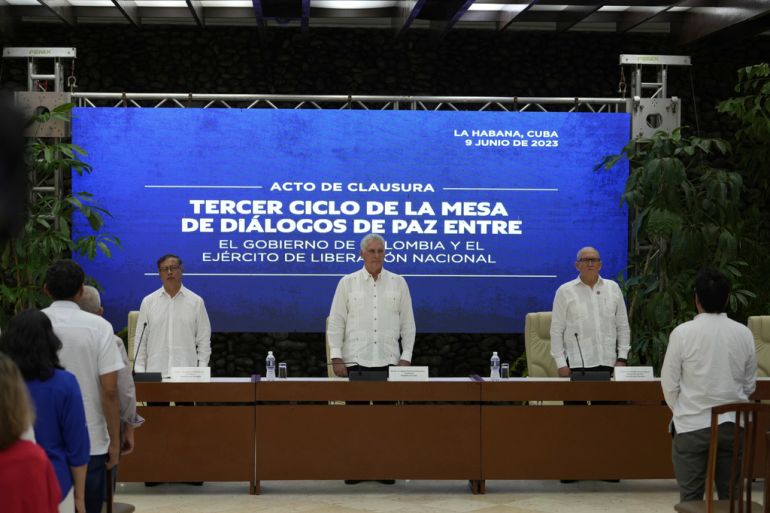Colombia and ELN rebel group sign ceasefire agreement
The agreement is a significant success for President Gustavo Petro’s agenda of ‘total peace’ after previous setbacks.

Colombia and the National Liberation Army (ELN) — the country’s largest remaining rebel group — have signed a ceasefire agreement following months of negotiations, marking a major milestone in President Gustavo Petro’s campaign for “total peace”.
Friday’s announcement is the culmination of a third round of talks, held in the Cuban capital of Havana. The national bilateral ceasefire will go into effect on August 3 and last for six months, as both sides seek to build trust.
Keep reading
list of 3 itemsEx-paramilitary leader testifies about assassinations in Colombia
Calls for ceasefire at start of latest Colombia-ELN peace talks
“This is considered very important here because the ELN that has been operating in an open conflict with the Colombian state since the 1960s have never signed a sort of full nationwide ceasefire,” Al Jazeera correspondent Alessandro Rampietti reported live from Bogota, Colombia.
“It would definitely be the biggest achievement so far in these peace negotiations that have been ongoing since the start of the government of President Gustavo Petro back in August.”
En las próximas horas estaré viajando a La Habana para asistir a la clausura del tercer ciclo de la Mesa de Diálogos de Paz. https://t.co/bFNpyzGIP1
— Gustavo Petro (@petrogustavo) June 8, 2023
The ceasefire agreement was initially expected on Thursday, but as Rampietti explained, the delegations involved “essentially asked for another 24 hours to iron out a number of details”. Petro himself flew to Havana on Thursday to be present at the signing ceremony, which was attended by ELN commander Antonio García and Cuban officials.
“Here, a new world is born,” Petro said at the ceremony on Friday. “Here a phase of the armed insurgency in Latin America ends.”
The agreement is the result of three rounds of successive negotiations, the first of which took place in December in Caracas, Venezuela. A second round occurred in Mexico City, followed by the third round in Havana, which launched in May.
But the months-long negotiations were tense, sometimes appearing touch-and-go. To allow García, the ELN commander, to attend Friday’s ceremony, the Colombian government had to drop an arrest warrant that it had previously issued for him.
García, for his part, was circumspect about Friday’s ceasefire. He was “very confident” in its terms, but he also described it as “procedural”, falling short of the “substantial” changes needed to end Colombia’s violence.

Colombia has been enmeshed in a nearly six-decade-long civil conflict, with government forces, paramilitary groups, left-wing rebels and criminal networks all jostling for power.
Petro, a former rebel himself, has promised to pursue a platform of “total peace” by seeking ceasefires with the armed groups that continue to operate in Colombia. Considered the country’s first left-wing president, Petro has sought to distance himself from the more aggressive tactics of his predecessors, by inviting these groups to the negotiating table.
A report by the country’s Truth Commission, released last June, was critical of the militarised approach pursued by previous administrations as an answer to the violence.
Though atrocities such as murder, kidnapping and torture have been carried out by all sides, the report found that the government and right-wing paramilitaries were responsible for the majority of the violence.
A turning point in the conflict came in 2016, when the government of then-President Juan Manuel Santos signed peace accords with the Revolutionary Armed Forces of Colombia (FARC), the largest rebel group at the time.
The peace deal required that the FARC disband as an armed force, in exchange for rural reforms, political participation, reparations for victims and other terms. But the dissolution of the FARC left a power vacuum, and dissidents to the peace accords — as well as rival armed groups like the ELN — have continued to engage in violence.
A report by the Red Cross earlier this year noted that, while the violence between military and rebel organisations decreased in 2022, Colombians continue to be displaced and maimed as armed groups fight for control of territory and resources.
Petro’s pursuit of “total peace” has experienced ups and downs: In late December, the Colombia president prematurely announced a New Year’s ceasefire with the ELN that he later had to walk back. Talks with other armed groups have broken down amid surges of violence.
For instance, in May, the government suspended a ceasefire in certain parts of the country with one armed group, the Estado Mayor Central (EMC), after the group killed several Indigenous teenagers.
Rampietti, the Al Jazeera correspondent, said Friday’s deal in Havana could give a much-needed boost to Petro’s political prospects, after weeks of scandal and opposition-led scepticism about his government’s peace talks.
“The government has been in the middle of a major political crisis here,” Rampietti said, referencing a recent controversy involving allegations of campaign finance violations.
Petro has also seen his agenda of social and economic reforms stalled for months in Congress. “So this will be very important,” Rampietti said of the ELN agreement.